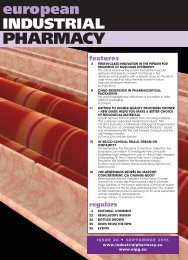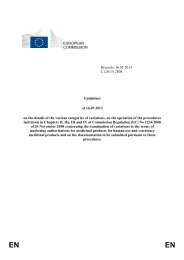PHARMACY
eip31-dec16
eip31-dec16
Create successful ePaper yourself
Turn your PDF publications into a flip-book with our unique Google optimized e-Paper software.
FORMULATION TECHNOLOGY CAN ENABLE ORAL DELIVERY OF NEW GENERATION MEDICINES<br />
continued<br />
amylose as the microflora-activated<br />
trigger polymer. It was developed<br />
to overcome the shortcomings of<br />
simply relying on a dosage form<br />
coated with glassy amylose to delay<br />
drug release 65 . Glassy amylose is<br />
not degraded by human amylase<br />
enzyme in the GI tract, but is<br />
digested by colonic bacterial<br />
enzymes. Glassy amylose alone is<br />
believed to imbibe fluid in the<br />
upper GI tract and swell, leading to<br />
weakening of the coat integrity and<br />
premature partial or complete<br />
release of the drug.<br />
The inclusion of a second polymer<br />
to control the swelling is required to<br />
better target drug release from the<br />
dosage form to the colon 66 . By<br />
adding a more hydrophobic<br />
cellulose ether polymer to the<br />
glassy amylose in the ratio 4:1 and<br />
5:1, along with a plasticiser, dibutyl<br />
sebacate and applying this to the<br />
drug-containing formulation in a<br />
fluid bed coater to a weight gain of<br />
10–20% w/w, a delayed release<br />
coating was produced which, when<br />
optimised successfully,<br />
demonstrated targeted release in<br />
volunteers. Based on analysis of<br />
recovered dosage forms, over 90%<br />
of the drug was delivered, yet<br />
plasma levels were much lower than<br />
for rectal administration of the same<br />
dose. Additionally, imaging the<br />
dosage forms by gamma<br />
scintigraphy in vivo, showed that<br />
plasma levels began to rise only<br />
after the dosage form had reached<br />
the ileocecal junction or the<br />
ascending colon, regardless of any<br />
delay in time to reach that region<br />
(fed state or fasted state) 67 . A<br />
potential commercial embodiment<br />
of the technology for the delivery of<br />
prednisolone metasulfobenzoate<br />
sodium is the formulation referred<br />
to as COLAL-PRED which has been<br />
the subject of human clinical trials.<br />
The concept raised some interest in<br />
its commercial potential and was<br />
licensed by the technology owner<br />
Alizyme to Norgine BV, Prometheus<br />
Laboratories and TSD Japan Inc 68 .<br />
The Phase 3 trial, however, failed to<br />
meet one of the primary endpoints<br />
for efficacy and the product appears<br />
not to have been pursued further 69 .<br />
CODES<br />
CODES represents a different<br />
approach to microflora-activated<br />
drug delivery from a coated dosage<br />
form that utilises the ability of<br />
colonic bacteria to degrade certain<br />
polysaccharides to organic acids.<br />
The drug-containing tablet core can<br />
contain lactulose, or is coated with<br />
lactulose. The tablet is then coated<br />
with amino methacrylate copolymer<br />
(Eudragit E), followed by a<br />
second coat of enteric polymer,<br />
methacrylic acid–methyl<br />
methacrylate copolymer (1:1),<br />
Eudragit L (see Figure 2). In a<br />
technology variation, a lactulosefree<br />
tablet, is coated with amino<br />
methacrylate copolymer and codosed<br />
with a second tablet<br />
containing lactulose coated with<br />
methacrylic acid–methyl<br />
methacrylate copolymer (1:1). The<br />
two tablets are enclosed in a<br />
methacrylic acid–methyl<br />
methacrylate copolymer (1:1)-<br />
coated capsule 70 . The dosage form,<br />
therefore, is activated in the colon<br />
by dissolution of the enteric coat.<br />
Colon microflora degrade lactulose<br />
to acid metabolites in the<br />
immediate vicinity of the<br />
therapeutic agent-containing tablet<br />
and that causes breakdown of the<br />
acid-soluble amino methacrylate<br />
copolymer to liberate the contained<br />
drug from the tablet core (Figure 2).<br />
The functionality of the<br />
technology was confirmed in an<br />
1<br />
2<br />
4<br />
Tablet core with lactulose<br />
3<br />
Acid-soluble polymer<br />
Polymer coating soluble at pH ≥7.0<br />
Figure 2. CODES technology. 1. Once in an environment where the pH is above the threshold for polymer<br />
dissolution (distal ileum), first coating layer dissolves exposing second layer. 2. Second layer is not soluble at pH of<br />
distal ileum and colon but allows fluid to penetrate to core. 3. Intestinal bacteria metabolise lactulose in core to<br />
acidic metabolites that cause dissolution of acid soluble coat. 4. With acid-soluble coat removed, drug is liberated<br />
from core at target site.<br />
12 european INDUSTRIAL <strong>PHARMACY</strong> December 2016 • Issue 31





